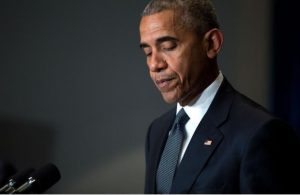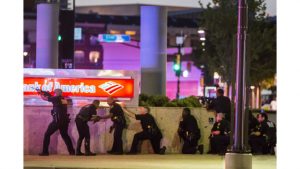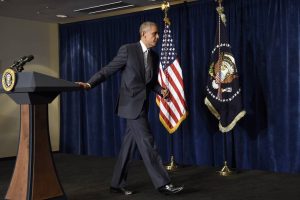 I am surprised that we are surprised every time these tragic events happen. Unfortunately, we shouldn’t be. Without tackling the issue at the root we are bound to repeat this unfortunate vicious cycle over and over. There is something eerily familiar about the recent terrible incidents in Dallas and Louisiana in the United States. The beginning, the subsequent fall out, the aftermath and the mainstream media coverage are also sadly predictable. The pattern is typically a variation of the following three stages:-
I am surprised that we are surprised every time these tragic events happen. Unfortunately, we shouldn’t be. Without tackling the issue at the root we are bound to repeat this unfortunate vicious cycle over and over. There is something eerily familiar about the recent terrible incidents in Dallas and Louisiana in the United States. The beginning, the subsequent fall out, the aftermath and the mainstream media coverage are also sadly predictable. The pattern is typically a variation of the following three stages:-
Generally, it usually starts when an ethnic minority is carelessly and needlessly shot dead / violated by a security officer or a ‘privileged’ member of the society. It is normally for either: ‘acting suspicious’, ‘resisting arrest’, ‘being a trouble maker ‘or simply because someone felt ‘threatened’ and hence acted in ‘self-defence’. (Note that, the victim doesn’t get to decide what acting suspicious, resisting arrest and feeling threatened mean).
Next, the victim’s family, mostly minority communities and some civil rights organizations would usually hold peaceful protests and demonstrations calling for ‘justice to be done’ and denouncing what they perceive as excessive use of force, police brutality or racism. At this stage, the dominant narrative from the establishment and the main stream media, would generally be ‘let us wait for all the facts to come out’, ‘police are doing a very hard job and the vast majority are very good people’, ‘the officer(s) had a stellar record in diversity training’. In some cases, they will also parade some ethnic minority police officers or an ethnic minority ‘friend’. Some would also allude to the now suspect’s history of battling depression or difficult family issues. (Note the slow shift from the victim to orchestrated efforts to exonerate the suspect). On the other hand, some sections of the media will characteristically start digging up the dirt for anything remotely controversial from the life of a now dead victim, the family and affiliated organizations. This ‘smear campaign’ is usually geared at neutralizing the sympathy and goodwill from the general public and the judicial, in case it ever makes it to the trial.
Lastly, in the course of peaceful protests, inevitably some criminal elements would attempt to infiltrate and hijack some of up till now peaceful demonstrations. Violence and vandalism would follow and sadly there may even be some further fatality. From here on, it is all over. The prevailing narrative will at this point generally shift in full swing to demonizing almost all protests as consisting of a bunch of criminals and thugs. Questions will also be raised and debates ensued about the efficacy of the methods of protests mainly from people who have no history of standing up against injustice and oppression. Those who were initially silent when a member from ethnic minority was tragically killed or assaulted will now be ‘outraged’. There will be calls for even more heavy-handed approach to contain the thugs and agitators and for people to arm themselves even further. Those who committed reactionary acts of violence and vandalism will be tried, found guilty and sentenced. The initial suspect would usually be acquitted if the case ever makes it to the courts. There will then be calls for ‘healing’, open and honest discussions on racism and police brutality. Nothing fundamental will get done and this tragic cycle will repeat itself over and over.
The Missing Narrative
- Lack of nuance, context is everything
 Any group of people regardless of their ethnic, social or educational background if they feel that they are systematically and continuously oppressed violated, marginalized (including economically) and under siege, will eventually react in similar ways. If they perceive, after repeated attempts, that there are no viable and trustworthy channels to resolve their predicament, they will resort to other ‘unconventional ways’. This desire to explicate oneself from the clutches of oppression and indignity is not only inherent in all human beings but is also unquenchable. That is how slavery and colonialism was overcome across the globe. That is how apartheid was ended in South Africa. We often forget, even the now celebrated Nelson ‘Saint’ Mandela at one point advocated and took to arms when he felt that conventional ways of fighting oppression and injustice were neither impartial nor bearing any fruit. Now of course I am not justifying nor advocating acts of violence. I am not even equating colonialism and apartheid to the current racism as practised in the US and throughout the West more generally. However, context is vital and there are parallels. Massive strides have been made but there is still a lot of work to be done.
Any group of people regardless of their ethnic, social or educational background if they feel that they are systematically and continuously oppressed violated, marginalized (including economically) and under siege, will eventually react in similar ways. If they perceive, after repeated attempts, that there are no viable and trustworthy channels to resolve their predicament, they will resort to other ‘unconventional ways’. This desire to explicate oneself from the clutches of oppression and indignity is not only inherent in all human beings but is also unquenchable. That is how slavery and colonialism was overcome across the globe. That is how apartheid was ended in South Africa. We often forget, even the now celebrated Nelson ‘Saint’ Mandela at one point advocated and took to arms when he felt that conventional ways of fighting oppression and injustice were neither impartial nor bearing any fruit. Now of course I am not justifying nor advocating acts of violence. I am not even equating colonialism and apartheid to the current racism as practised in the US and throughout the West more generally. However, context is vital and there are parallels. Massive strides have been made but there is still a lot of work to be done.
- Ethnic minorities do not have monopoly over Nonviolence
There have been tendencies to bandy around some Martin Luther King Jr’s (MLK) quotes on nonviolence every time a tragic incident happens and there is outrage in communities. It is true that MLK employed nonviolent methods in his campaigns for civil rights. However, the principle of nonviolence should not be consigned to just ethnic minorities. Everyone should endeavour to practise nonviolent means, including the police and the wider public. MLK did speak out against violence in a number of occasions. For instance, he once warned, “in spite of temporary victories, violence never brings permanent peace.” He also cautioned “we must not allow our creative protest to degenerate into physical violence.” He was clearly wary of utility of blind rage and hate. He is often quoted to have said “darkness cannot drive out darkness; only light can do that”.
 Moreover, he also spoke out clearly against the dangers of oppression and injustice left unchecked. In his famous, ‘I have a Dream Speech’, he proclaimed “the whirlwinds of revolt will continue to shake the foundations of our nation until the bright day of justice emerges.” And in his ‘Letter from a Birmingham Jail’, he wrote, “Oppressed people cannot remain oppressed forever. The yearning for freedom eventually manifests itself”. In his 1967 ‘Steeler Lecture’ he wrote “in the end, we will remember not the words of our enemies, but the silence of our friends”. In other words, he reminded us that if we choose to remain silence in the face of injustice and oppression, then by default we have chosen the side of the oppressor. Both the killing of police and by police should be equally condemned. Just because one kills while in uniform is neither necessarily legal nor justifiable.
Moreover, he also spoke out clearly against the dangers of oppression and injustice left unchecked. In his famous, ‘I have a Dream Speech’, he proclaimed “the whirlwinds of revolt will continue to shake the foundations of our nation until the bright day of justice emerges.” And in his ‘Letter from a Birmingham Jail’, he wrote, “Oppressed people cannot remain oppressed forever. The yearning for freedom eventually manifests itself”. In his 1967 ‘Steeler Lecture’ he wrote “in the end, we will remember not the words of our enemies, but the silence of our friends”. In other words, he reminded us that if we choose to remain silence in the face of injustice and oppression, then by default we have chosen the side of the oppressor. Both the killing of police and by police should be equally condemned. Just because one kills while in uniform is neither necessarily legal nor justifiable.
In sum, of course all lives matter, that’s given. However, without understanding the rationale that gave rise to ‘Black Lives Matter’ movement, the ‘#AllLivesMatter’ becomes a distraction, counterproductive and at worst, offensive. Let’s not get confused, ‘#Black Lives Matter’ is not a fad or a vacuous social movement conceived out of craving for attention or a sense of superiority to denigrate other ‘races’. It’s quite the opposite. It is an attempt to bring to attention and address the historical and the current disparity that statistics bear out. It is an effort to truly get to a point where all lives really matter. In theory and in perfect world, there wouldn’t be a need for #Black Lives Matter, because black lives are embedded and part of all lives. The #AllLivesMatter can, in theory swiftly put this #BlackLivesMatter to rest by making sure in practice all lives really matter. In other words #BlackLiveMatter is agreeing with #AllLivesMatter. But it goes a step further and asks #All Lives Matter to be true what it says on paper!

